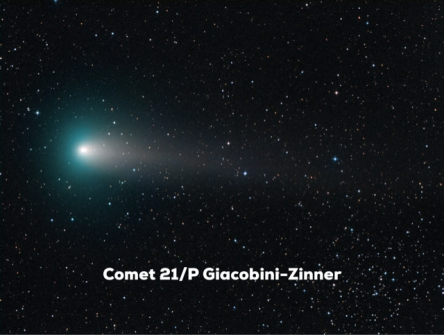
To best appreciate this month’s feature object, we must go back in time 4.6 billion years ago to when our solar system was born. Prior to this, the solar system was nothing more than a gleam within the eye of a cloud of interstellar gas and dust orbiting two-thirds of the way out from the center of the Galaxy. The cloud was probably anywhere from 50 to 100 light years in diameter and it was made mostly of molecular hydrogen (a simple molecule of two bound atoms of hydrogen) and helium, with trace amounts of carbon, nitrogen, and oxygen. Plus, a pinch of silicate materials and metals thrown in for good measure. The cloud would also have been very cold, with temperatures right around -250 degrees Celsius, any warmer and the hydrogen molecules would have fallen apart.
4.6 billion years ago, the cloud of gas and dust began to collapse in upon itself, the collapse perhaps having been triggered by the passage of a nearby massive star, or from the shockwave generated by a star that had destroyed itself in a supernova explosion. Whatever the trigger was, the cloud, would have developed multitudes of dense knots of gas within it. These individual knots served as nuclei that, due to their density, were able to use their gravity to start pulling in more and more gas from their immediate surroundings. Some of these knots, perhaps hundreds, or even thousands of them, were destined to become stars, one of them was our Sun.
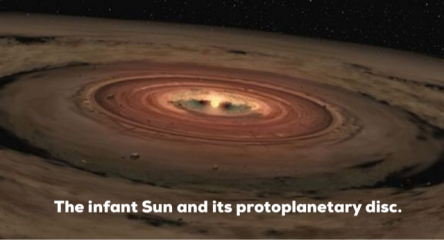 As our embryonic Sun began to take shape, its knot of gas would have begun to spin and flatten itself out into a disk. Millions of years would have been required before the center of this disk could become dense and hot enough for nuclear fusion to begin, but once it did, the Sun was born. Whenever you have a big construction project you are also going to end up with leftover material, the same thing happened with the formation of the Sun. After the Sun pulled in all the material it needed for its own creation, it left behind a thinner, spinning disk of gas and dust. Over the next two or three million years, as the disk began to cool, grains of silica, metals, and ice would begin to condense out of it. These particles would then begin to collide with one another in order to form the Sun’s family: planets, moons, asteroids, and comets. While the Sun formed from a top-down process, the solar family was constructed from the bottom-up.
As our embryonic Sun began to take shape, its knot of gas would have begun to spin and flatten itself out into a disk. Millions of years would have been required before the center of this disk could become dense and hot enough for nuclear fusion to begin, but once it did, the Sun was born. Whenever you have a big construction project you are also going to end up with leftover material, the same thing happened with the formation of the Sun. After the Sun pulled in all the material it needed for its own creation, it left behind a thinner, spinning disk of gas and dust. Over the next two or three million years, as the disk began to cool, grains of silica, metals, and ice would begin to condense out of it. These particles would then begin to collide with one another in order to form the Sun’s family: planets, moons, asteroids, and comets. While the Sun formed from a top-down process, the solar family was constructed from the bottom-up.
Close in to the Sun, conditions were too hot for the gas and ices to hang around for very long and, so, this region favored the formation of worlds made of rock and metal. Further out from the Sun, cores of rock and ice could form that were able to wrap themselves in what remained of the gas disk and, so, the gas and ice giant planets could form. Further out still, on the fringes of the solar system, beyond “the snowline”, the ices and frozen gases formed into trillions of miniature worlds all their own. I offer you this preamble in order to help provide you some vistavision perspective on this month’s sky feature, Comet 21/P Giacobini-Zinner. It’s one thing to see a faint and fuzzy comet in your binoculars, or small telescope, and appreciate its delicate beauty from a purely aesthetic sense, but it takes on an added level of significance when you can also place it within a much larger context.
WHEN AND WHERE TO LOOK
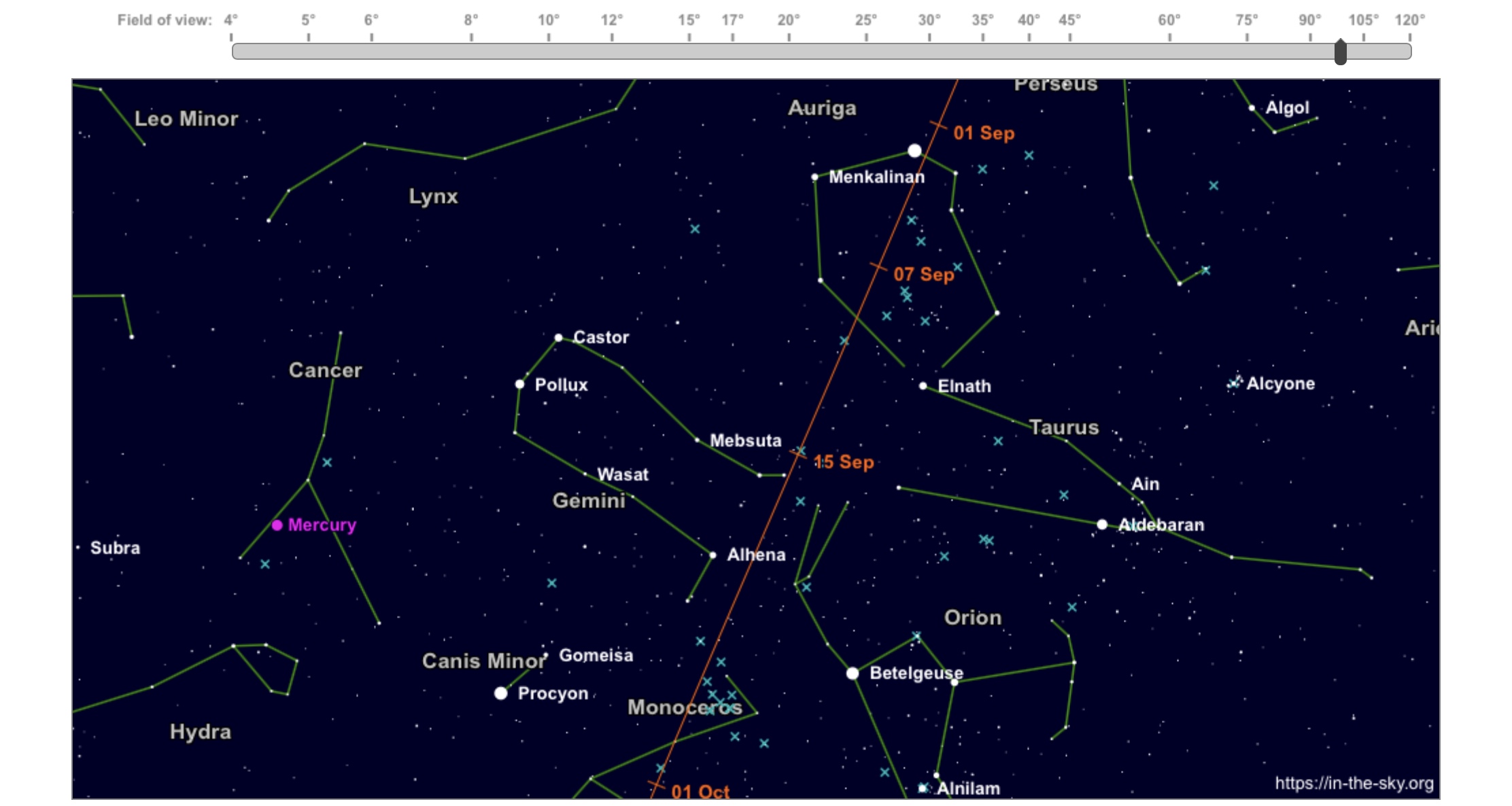
You’ll have to get up pretty early in the morning to catch Comet 21/P this month. No, really. Throughout August, the comet has been a nice binocular object during the late evening, but now, as it heads towards perihelion (the day that it makes its closest approach to the Sun), we will only see it in the hours after midnight. As it moves against the background stars, Comet 21/P will pass by some distinctive night sky “signposts” that can help you find it. Use a star chart or an astronomy app to help you pinpoint its location upon the sky.
Here is a list of significant dates for the comet’s wanderings across the sky:
• September 2: 21/P will pass within just one degree of the bright star Capella in the constellation of Auriga. With binoculars, you should be able to get both the star and the comet in the same field of view.
• September 7/8 The comet is within 2 degrees to the left of the open star clusters Messier 38 and Messier 36 in Auriga.
• September 10 The comet is less than a degree away from the open star cluster Messier 37 in the constellation of Auriga. This will be a great photo opportunity for astrophotographers. This is the date of perihelion, and the comet should be at its brightest with a magnitude of +7, putting it right below naked-eye visibility but within easy reach of binoculars and small telescopes.
• September 11 Comet 21/P is at its closest distance to Earth at a distance of around 36 million miles (0.392 AU). For comparison, on April 20, 1910, Comet Halley passed within just 14 million miles of Earth.
• September 13 From about 3:30 AM until about an hour before sunrise, look for the comet skirting the eastern borders of the constellation of Taurus. Draw a line in between the stars Elnath and Zeta Tauri, the comet should be to the east of the midway point between these two stars.
• September 14 Look to the NE of the star 1 Geminorum in the constellation of Gemini in order to find 21/P
• September 15 Another great photo opportunity, the comet will be passing right in front of the open star cluster, Messier 35 in the constellation of Gemini.
• September 16 You can find the comet just below the ecliptic (the imaginary line upon the sky which represents the plane of our solar system) and above the + 3 magnitude star Propus in the constellation of Gemini.
• September 17 Comet 21/P now lies just below (SW) of the star Propus.
• September 21 Draw a line in between the star Alhena in Gemini and Betelgeuse in Orion. The comet is less than a third of the way along that line out from Alhena.
• September 23 Draw a line in between the stars Xi Geminorum in Gemini and Betelgeuse in Orion, the comet is about a third of the way along that line out from Xi Geminorum.
• September 24 Comet 21/P is now just to the NW of NGC 2264, the Christmas Tree Cluster, in the constellation of Monoceros.
• September 31 Comet 21/P less than a degree away to the SW of open star cluster NGC 2301 in the constellation of Monoceros during the late morning hours.
Comets can be fickle objects and difficult to locate on the sky. But Comet 21/P Giacobini-Zinner is not really one of those. Currently, the comet is performing according to expectations. By the time it reaches perihelion, it should be a lot easier to locate provided you are observing from a dark sky locale with no moon or clouds to mar the view. My suggestion is to first try and locate the comet with binoculars. If you aren’t sure exactly where it is upon the sky, use a sky chart or app to narrow down the general area and then slowly scan the sky with your binoculars. Once you locate it, use a small telescope, if you have one, for a closer view. Remember, start out with a low power eyepiece and then increase the magnification once you’ve found it. 21/P should be a fine binocular target over the first half of the month. However, as the month ends, it will probably have dropped considerably in brightness and will be best as a telescope object.
 Stellarium is a free, open source planetarium software for your computer, use it to find Comet 21/P as well as many other sky objects. http://stellarium.org
Stellarium is a free, open source planetarium software for your computer, use it to find Comet 21/P as well as many other sky objects. http://stellarium.org
WHAT YOU ARE SEEING
First off, let’s talk about the name, 21/P Giacobini-Zinner. The letter “P” tells us that this is a periodic comet, one whose orbit around the Sun is less than 200 years. In fact, 21/P makes a complete trip around the Sun once every 6.6 years. The name “Giacobini-Zinner” is derived from the comet’s co-discoverers. Michel Giacobini first observed the comet from the Nice Observatory in France on December 20, 1900. In 1913, the comet was again observed by German astronomer Ernst Zinner.
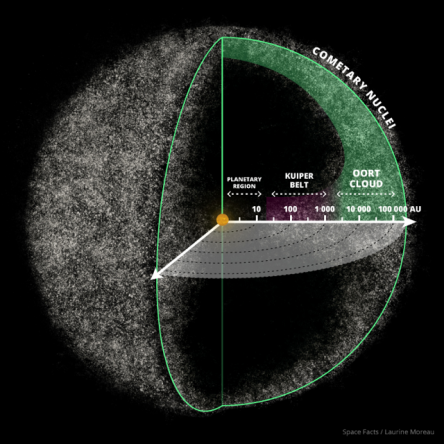 There are two primary reservoirs for comets in our solar system, the first, is a belt of debris that lies beyond the orbit of Neptune and is often called “the Kuiper Belt” (after American astronomer Gerard Kuiper who first proposed its existence) and the second is known as “the Oort Cloud” (after Dutch astronomer Jan Oort), and is a vast shell of icy bodies that surrounds the solar system.
There are two primary reservoirs for comets in our solar system, the first, is a belt of debris that lies beyond the orbit of Neptune and is often called “the Kuiper Belt” (after American astronomer Gerard Kuiper who first proposed its existence) and the second is known as “the Oort Cloud” (after Dutch astronomer Jan Oort), and is a vast shell of icy bodies that surrounds the solar system.
The Kuiper Belt is also said to have a second component to it known as “the Scattered Disc”. It is thought that the short period comets have their origins from within the Kuiper Belt and the Scattered Disc (it’s also home to the dwarf planet Pluto) while the long period comets, those whose orbital periods are greater than 200 years, are from the Oort Cloud. Some of the Kuiper Belt/Scattered Disc objects, find their way into the inner solar system only to have their orbits primarily influenced by Jupiter’s gravitational dominance. 21/P is one of these comets. During its perihelion, 21/P comes to within 1.038 astronomical units (AU) of the Sun (one AU is the Earth-Sun distance of 93 million miles). At aphelion, its most distant point from the Sun, Comet 21/P is just beyond the orbit of Jupiter at 6.014 AU.
You will often hear comets being referred to as “dirty snowballs”, that’s because they are not made of pristine ice, instead, comets are often made of dust and bits of rocky material contained within a matrix of water ice as well as frozen gases such as carbon dioxide, carbon monoxide, methane, and ammonia. Dirty snowballs indeed. These snowballs of various materials are called the comet’s “nucleus” and they have diameters that average from 2 miles across to around 10 miles. Comet 21/P Giacobini-Zinner is a tad bit on the dinky side with a diameter of 1.24 miles.
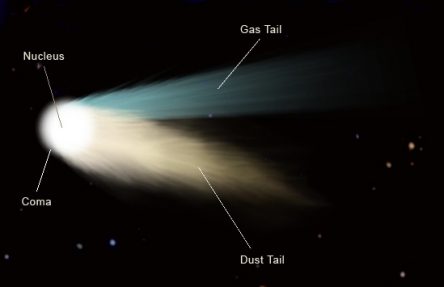 Once a comet passes the orbit of Mars, the Sun’s energy begins to make the ices in the nucleus “sublimate”, or, rather than melting, they go directly from being a solid to a gas. This diffuse cloud of gas surrounds the nucleus and is called the “coma”, which may be thousands of miles in diameter (larger than many planets!). As the comet nears the Sun, it may sprout a tail, which is just an extension of the coma as it interacts with the solar wind, a stream of charged particles being emitted by the Sun. The comet’s tail always points away from the Sun, irrespective of its direction of travel. Some comets might even produce two tails. One of these is known as the “ion tail”. As the solar wind interacts with the gases from the comet, it strips electrons off of the atoms and molecules that make up the gas. When the electrons recombine with the atoms and molecules, they emit a soft blue light. This bluish color is specific to carbon monoxide. Ionization of the atoms and molecules of other elements will produce different colors. Recent photographs of 21/P show a coma that is greenish in color, this is a result of the ionization of cyanogen and diatomic carbon. The other type of comet tail is the “dust tail”, as the name implies, this is made up of bits of dust as well as sand grain and pea-sized bits of debris. The dust tails often appear a soft yellow color.
Once a comet passes the orbit of Mars, the Sun’s energy begins to make the ices in the nucleus “sublimate”, or, rather than melting, they go directly from being a solid to a gas. This diffuse cloud of gas surrounds the nucleus and is called the “coma”, which may be thousands of miles in diameter (larger than many planets!). As the comet nears the Sun, it may sprout a tail, which is just an extension of the coma as it interacts with the solar wind, a stream of charged particles being emitted by the Sun. The comet’s tail always points away from the Sun, irrespective of its direction of travel. Some comets might even produce two tails. One of these is known as the “ion tail”. As the solar wind interacts with the gases from the comet, it strips electrons off of the atoms and molecules that make up the gas. When the electrons recombine with the atoms and molecules, they emit a soft blue light. This bluish color is specific to carbon monoxide. Ionization of the atoms and molecules of other elements will produce different colors. Recent photographs of 21/P show a coma that is greenish in color, this is a result of the ionization of cyanogen and diatomic carbon. The other type of comet tail is the “dust tail”, as the name implies, this is made up of bits of dust as well as sand grain and pea-sized bits of debris. The dust tails often appear a soft yellow color.
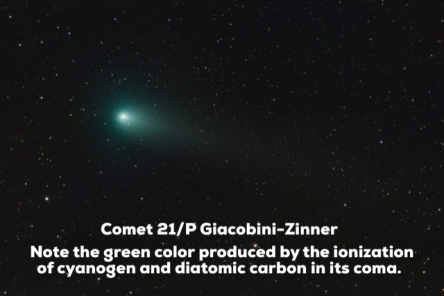 These dust tails can stretch out for thousands or millions of miles in space, whenever the Earth plows through one, we get a meteor shower. In fact, 21/P Giacobini-Zinner is the parent source for the annual Draconid Meteor Shower, seen around the nights of October 8th and 9th. Normally, the Draconids are rather lackluster in terms of numbers, but, some years (as in 1998, 2005, and 2011) there can be veritable storms of Draconids with outbursts producing hundreds of meteors per hour. These outbursts are often associated with recent passages of 21/P after it has replenished the meteor stream. Another name for the Draconid meteors is “tears of the dragon”. Will the dragon weep plentifully this October? No one knows for sure just yet, but it might be worth keeping an eye on. Either way, get outside this month and see if you can observe this early relic from our solar system’s ancient past.
These dust tails can stretch out for thousands or millions of miles in space, whenever the Earth plows through one, we get a meteor shower. In fact, 21/P Giacobini-Zinner is the parent source for the annual Draconid Meteor Shower, seen around the nights of October 8th and 9th. Normally, the Draconids are rather lackluster in terms of numbers, but, some years (as in 1998, 2005, and 2011) there can be veritable storms of Draconids with outbursts producing hundreds of meteors per hour. These outbursts are often associated with recent passages of 21/P after it has replenished the meteor stream. Another name for the Draconid meteors is “tears of the dragon”. Will the dragon weep plentifully this October? No one knows for sure just yet, but it might be worth keeping an eye on. Either way, get outside this month and see if you can observe this early relic from our solar system’s ancient past.